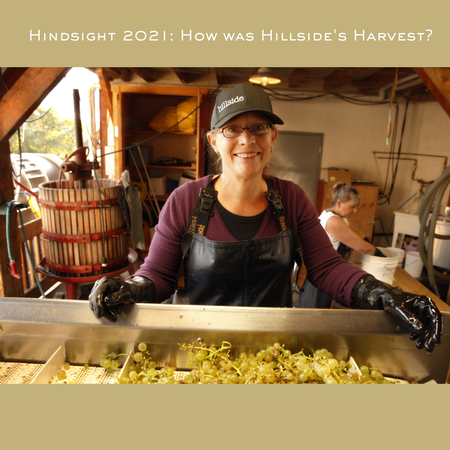We faced harvest this year with no idea of what we might find. The “heat dome” in mid-June brought record temperatures at a highly unusual time for wine-growing regions. As this period is typically when we see “bloom” – flowering of these self-pollinating vines – I expected to see anomalies in both time of ripening and yields that would vary from variety to variety.
Yep—sure enough—anomalies. The first grape we typically pick is our Muscat Ottonel, the original white planted by Vera Klokocka back in 1983, which is a cool-climate, early ripening variety.This year however, our first block picked was Pinot Gris, and Pinot Gris from one of the cooler sites we have contracted! It’s a bit further north and higher elevation than most of our Pinot Gris sites. As for most phenomena, I have a theory. Likely the cooler site allowed the vines to glean some extra heat units during those times of the day their counterparts in warmer sites were “shut down”, a protective mechanism which allows vines to preserve moisture.
We in the wine industry measure the amount of heat during the growing season by Growing Degree Days (GDD). This is calculated by accumulating the number of degrees above 10º C that the daily average reaches, day by day from April 1st to October 31st. Typically, Bordeaux and Napa see 1600-1800 GDD, as does Osoyoos, while the Summerland/Naramata area average GDD has been ~1350. 2021 will go onto the record books as the hottest season for Naramata with a GDD of 1555.However, much of this accumulation was during the heat dome when vines spent the mid-part of the day not working, so this may be misleading.
A week after that first block of Pinot Gris we did pick our Muscat Ottonel and found that the yield was right on our 10-year average yield. Sadly, no other block followed suit, with yields typically 25-30% below normal (bad news). Perhaps the fact that muscats are early ripening allowed it to enter the bloom phase before the heat dome hit, ensuring complete fertilization and development of the berry. We also found the flavour and mouth feel to be the best we’ve seen in this variety. And, with regards to flavour and mouthfeel, the other varieties did follow suit (good news).
More bad news: everything ripened around the same time. Good news?: we crushed our last grape on October 23rd—one of the earliest end dates we’ve seen. More good news—it all fit in the winery! As winemaker, this has given me the ability to fine-tune what we do—get just the right amount of skin contact and heat for each tank to bring out the greatest potential of the fruit. It’s early days yet, but the wines that are finishing fermentation are really exciting. Watch for early spring releases of our 2021 Un-oaked Pinot Gris, 2021 Gewürztraminer, and 2021 Rosé.

